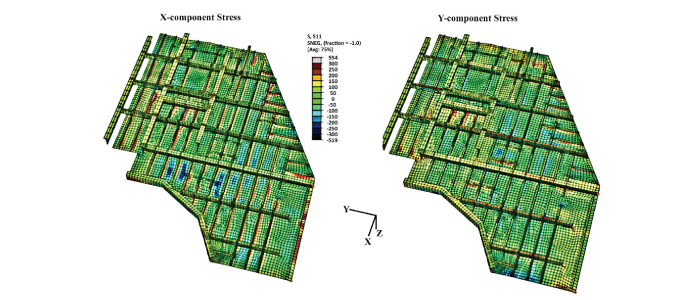Above: Engineers at Emc2 use the welding design software package known as Virtual Fabrication Technology, or VFT, to visualize residual stresses in an oil rig panel. Control of these stresses can improve fatigue and corrosion life in deep sea drilling platforms.
The use of virtual design in the fabrication of large structures has enjoyed significant success in the heavy materials industry for almost two decades. Industries that have used virtual design and analysis tools have reduced material parts size, developed environmentally friendly fabrication processes, improved product quality and performance and reduced manufacturing costs.
To boost this early success to a new level, the Engineering Mechanics Corporation of Columbus (Emc2) and its partners earlier this year secured a $1 million grant from the U.S. Department of Energy to develop a cloud-based tool that will simulate welding processes employed in the manufacture of metallic products. The funding was awarded through the federal agency’s Small Business Innovation Research (SBIR) program, which encourages small businesses to develop and commercialize new technologies.
“Small and mid-sized manufacturing firms (SMMs) need improved weld-fabrication processes to ensure improved quality at lower costs to remain globally competitive,” said Frederick “Bud” Brust, Ph.D., senior research leader at Emc2. “We are developing a sophisticated high performance computing based tool and making it accessible to SMM firms from a supercomputer center to easily permit use of these tools at affordable prices.”
Emc2 seeks to adapt a welding design software package known as Virtual Fabrication Technology, or VFT, to a more accessible, open-source “manufacturing app” format through the Ohio Supercomputer Center’s AweSim industrial engagement program. The project involves leveraging the existing code to address a broader range of applications and products for widespread use by SMMs.
VFT is a mathematics-based computational tool that allows manufacturing designers to better control distortion, minimize residual stresses, and pre-determine welding parameters, such as weld-sequencing, pre-bending and thermal-tensioning, using various inputs, such as material properties and consumable properties. The code was developed in conjunction with Caterpillar in the late 1990s and currently is used by equipment manufacturers to design and model large welded structures prior to fabrication. Emc2 has licensed VFT for use across a broad range of fields, such as nuclear energy, shipbuilding and national laboratories.
Emc2 has made numerous improvements to VFT over the years to permit SMMs to take greater advantage of the benefits of high performance computing. Now, with the development and promotion of this simplified, affordable app version, SMMs will be able to access resources that could significantly reduce or eliminate undesirable outcomes prior to fabrication and avoid costly design changes after fabrication.
Project Lead: Frederick “Bud” Brust, Ph.D., Engineering Mechanics Corporation of Columbus
Research Title: Adoption of high performance computational (HPC) modeling software for widespread use in the manufacture of welded structures
Funding Source: Department of Energy
Website: http://www.emc-sq.com/fea_code_devel.html

